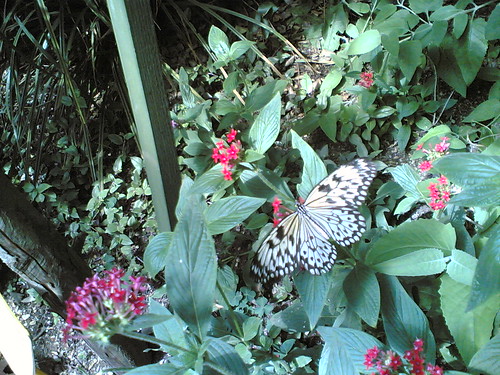“Deep above our heads, branches reaching far across interstellar space, grows the Moon Blossom Tree. When the solar wind blows, its branches shake and thousands of cosmic petals gently float to earth, landing in drifts and patches across our home. The tree is home to space caterpillars, who eat the petals and grow into astral butterflies: when the wind blows, how will they find food to eat while the petals grow back?
Fortunately, when the petals have fallen to Earth they can be found. Mobile phones let players see things from the Moon Blossom world, and so they can be used by players to look for petals and to see the caterpillars. People who find these petals can send them back to a particular caterpillar and watch it grow. When it becomes a butterfly, perhaps it’ll remember the person who helped it grow up, and say hello as it flies past.”
This was the basis of a game I wanted to make in 2006, exploring the new location-based possibilities and casual game behaviours that were beginning to emerge. People would have been able to see augmented reality petals lying around them, on their way to work or school, by the door of their cafe, going home from the pub, tiny piles of glowing cosmic debris nestled in amongst the cigarette ends and drinks cartons collected in the gutter. The main play activity was collecting petals – different meteorological events would offer different types of petals, each offering their caterpillar recipients different capabilities. The rare ones could be traded, the duplicates given to friends, the seasonal ones shared online: some sort of petal economy would have emerged, which was interesting to me, and all the time people would be helping and nurturing rather than destroying or colonising. Of course it all seems a bit dated now (in one of the proposals I submitted I notice the line “Nokia has stated that GPS will be standard on all future phones”) and in many ways the social behaviours I wanted to explore have changed. Asking how mobile game play might fit into everyday life is less relevant when people shape everyday life around mobile use. And now that connection speeds and video displays are more sophisticated, most people I see plugged in on the MRT are just watching TV shows, anyway.
But still. It would have been lovely, a little slice of poetry and care in peoples’ lives, and last week I met someone who might have been keen to make it. So you can imagine how much my heart sank when I saw posters for “iButterfly” around Singapore. iButterfly is “a location based gamification coupon redemption mobile application that utilize GPS, Motion Sensor & Augemented Reality technology, which makes discounts and coupons become FUN!” You can get free crisps from Cheers stores and 10% off noodles at Yoshinoya. Leaving aside the fact that a lot of people in Singapore seem to find discounts and coupons a lot of fun already, the app has a nice gestural interface for waving a net to catch butterflies, and it’s nice that there’s a coherent role for your device in the story – it’s a net now. But I don’t think there’s room for two mobile location-based butterfly-focused activities in Singapore. Especially when one is about caring and thinking about the world outside Singapore, and the other gets you free stuff.
